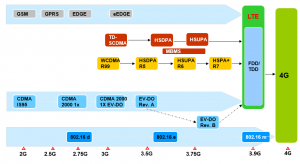The global utilities sector is in the midst of a major upgrade. Traditional utilities known for their stability, reliability, and predictability are in transition and have the opportunity to build next-generation technologies to implement efficient, powerful solutions that are safe, reliable, and compliant with regulatory standards.

One of the most effective ways to address these challenges is the rapid adoption of IoT (Internet of Things) technologies running on LTE cellular. IoT can help simplify multiple device use cases into a cohesive network, increasing efficiency and reducing overhead. The dynamic capabilities of IoT will increase productivity and efficiency for utilities looking to modernize and meet new standards in the industry, while opening the door to new business opportunities.
What is LTE technology?
LTE (Long Term Evolution, long-term evolution technology) is a wireless communication technology developed under the leadership of 3GPP. To be precise, LTE is not equal to 4G, it is a transitional technology between 3G and 4G. We prefer to call it “quasi-4G” or “3.9G”. LTE mainly has two standards: TD-LTE (time division duplex, used by China Mobile) and LTE-FDD (frequency division duplex, used by China Unicom and China Telecom).
If nothing else, LTE will continue to evolve and become an important technology in 5G networks.
peak rate
Downlink 100Mbps, Uplink 20Mbps
time delay
Control plane IDLE → ACTIVE: <100ms
User plane: one-way transmission <5ms
Mobility: 359km/h
Spectrum flexibility
1.4MHz, 3MHz, 5MHz, 10MHz, 15MHz, 20MHz variable bandwidth
Support global mainstream frequency bands, and support new frequency bands at the same time
LTE radio interface protocol
NAS layer (non-access layer): refers to the upper layer of AS (Access Stratum, access layer). NAS signaling refers to messages transferred between UE and MME.
RRC layer (Radio Resource Control): handles all signaling between UE and E-UTRAN.
PDCP layer (Packet Data Convergence Protocol): On the control plane, PDCP is responsible for encryption/decryption and integrity verification of RRC and NAS signaling messages. On the user plane, the function of PDCP is slightly different, it only performs encryption/decryption, and does not perform integrity check.
RLC layer (Radio Link Control): Provides the control function of the radio link. It includes three transmission modes: TM, AM, and UM, and mainly provides functions such as error correction, segmentation, concatenation, and reassembly.
MAC layer (Medium Access Control): The main functions are mapping, multiplexing, HARQ and radio resource allocation.
Physical Layer (Physical Layer): Provides a series of new flexible channels while taking full advantage of the characteristics and mechanisms of previous systems such as UMTS.
Utilities rely on the connectivity and communication of many different devices in the smart grid. Some line monitoring devices require the low latency and instant response speed of their network. Others, like smart meters, can operate with longer latencies and only need to transmit data at certain intervals. To address the diversity of use cases, many utilities segregate their equipment into many smaller proprietary non-LTE networks that are customized for specific use cases. This allows them to run each device at the speed and latency that suits each device, but the process creates a fragmented network that is challenging to operate and still not as economically friendly as the more efficient, multi-purpose LTE network.
LTE supports operation on multiple frequency bands, providing broadband and narrowband connectivity depending on device requirements. With the introduction of LTE as the wireless technology for grid modernization, utilities are now able to deploy a single multipurpose network for multiple use cases. Regardless of the specific needs of the network, the flexibility of LTE makes it an ideal solution for all use cases.
picture
single network function
A single network enables companies to scale faster and operate efficiently. LTE networks are designed to reuse and allocate resources across different use cases of the network. This enables efficient use of resources that can be applied to both narrowband and wideband applications. The size of the common assets of broadband and narrowband NB-IoT and CAT-M1 is highly dependent on the traffic intensity and planned volume of each technology. LTE is flexible enough to allow simultaneous use of all three technologies on a single site, with careful planning.
Broadband and Narrowband Coverage
One of the ways in which LTE provides flexible, practical solutions for all sectors of the business is through its simultaneous implementation flexibility, such as support for CAT-4, CAT-1, NB-IoT and CAT-M1 devices. Wideband implementations in LTE (e.g. LTE support for CAT-4, CAT-1) provide high throughput and speed over wider LTE channels, typically for fixed wireless or mobile applications.
Narrowband implementations such as NB-IoT and CAT-M1 provide deeper coverage at higher latency and slower speeds. By balancing spectrum usage against equipment demand within a single network, utilities can address performance and coverage use cases with maximum efficiency.
